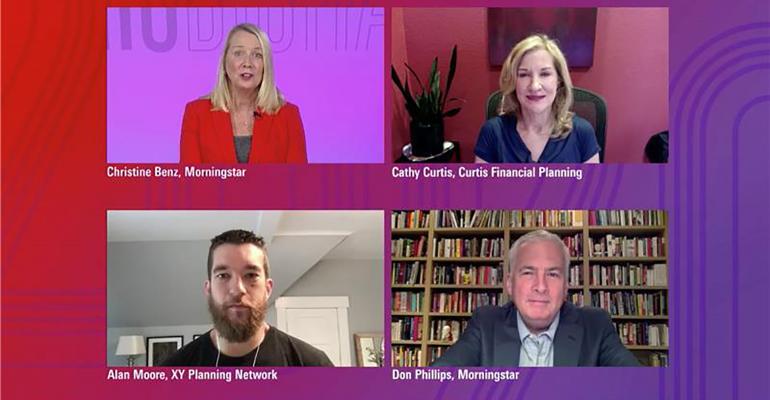The future of the advice business will integrate more technology, abandon geography as a market in favor of client niches and, regardless of recent pushes to the contrary, still rely on the AUM compensation model, according to a guest panel at the Morningstar Investment Conference on Wednesday.
The conference, held fully digital for the first time, was itself a look into the future, with some registrants paying $699 to receive an Oculus Quest headset for a "front-row" virtual reality seat to the seminars and sessions from the comfort of their own homes or offices.
For example, in the future of advice panel, financial planner Cathy Curtis logged in from her office in Oakland, Calif., XY Planning Network’s co-founder Alan Moore signed on from his home in Bozeman, Mont., and Morningstar's former CEO and managing director Don Phillips was sitting in front of impressive-looking bookshelves from Chicago.
The digital nature of the panel and conference, of course, was due to the ongoing coronavirus pandemic, which forced firms large and small to close their offices this spring. While smaller firms welcomed working from home ahead of the pandemic, once large firms committed to the majority of their staff being home for months, it opened the doors to a new way of working.
“What we really see is that there are some firms that will close their office—they’ll get a lot of media coverage—but it will be the minority," Moore said. "There’s not going to be very many that do that.”
He added that the industry will embrace a more flexible workforce, with remote work becoming normalized and firms more willing to hire employees who don’t live near their offices.
“I think it will allow us to be more specific about our ideal client and market to them whether they live near our office or not,” he said.
It took Curtis a while to find her ideal clientele, but once she did, her business took off. She said finding the right niche of independent single women about 12 years ago has been the key to building $72 million in assets across 63 accounts.
"The narrower you go, the better and your business will grow," Curtis said.
“Investment is the art of matching the investment to the investor," Phillips added. "And the more you know the investor, the more focused you are and the more value you can add."
Phillips pointed out that it is becoming progressively harder to add value on the investment side, but the areas that advisors are having success in are tax and financial planning.
“Look at the huge shift we’ve had from the Obama era taxes to the Trump policies to what may be in the near future more Democratic policies," he said. "How you navigate all of this is going to be much more important than the investment decisions that you make.”
Adding that onto the focus of clients’ values only enhances advice, Phillips said.
That's also why personal human advice is not going anywhere, even though some parts of a financial advisor's job can be better run by a computer or algorithm.
“One of the reasons I chose women as my niche is because women like to talk," Curtis said "They make it easy for me to help them because they let me know what they're thinking and rarely is it about what kind of investment return can you get me. So, the personal in planning is always gonna be there."
But Moore said robo advisors like Betterment, Wealthfront and Personal Capital influenced advisors’ custodians to finally implement technology to open an account and streamline back-office solutions that offer no value add to the client.
“It’s allowing the advisors to really streamline their practice so that they can either work with more clients or they can go deeper with their clients with a deeper level of expertise,” he said.
Philips added that what the robo advisors are also able to do is expand the market. They are popular among young investors or investors with small assets, a segment of the market that gets little attention from human advisors.
Those types of clients also aren't best-served by the AUM compensation model, Philips said. That's part of the reason why the flat-fee model is rising in popularity.
Curtis said she offers a hybrid model of both AUM and a flat fee that meets the need of differing finances. But her firm does cap who she’s willing to assist. When young prospects approach her for financial planning services, she refers them to an advisor she’s partnered with who needs to build relationships and doesn’t mind making a project out of the recently opened 401(k).
“We’ve historically said, ‘Well, young people don’t have enough money to pay for financial advice. That isn’t true,” Moore said. “What they didn’t have was enough assets to base an AUM fee on, but they had income, they had cashflow. And what we found is that they’re willing to pay for financial advice, you just have to have a business model that serves them.”





